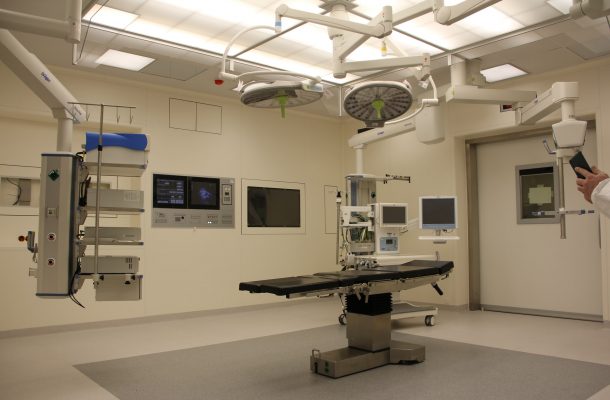5 design trends reshaping healthcare institutions

The healthcare industry is one of the most rapidly-changing industries in the world, and for a number of key socio-economic and political reasons. Not only are healthcare institutions and their prized medical staff required to keep up with the latest technological and medical innovation in order to retain their competitive advantage in the private healthcare sector, but it’s also important to note that modern patients require nothing less than contemporary treatment and safer hospitals.
To provide all of this, business leaders in this sector must stay on top of the latest trends and strive to pioneer the implementation of new solutions and designs. From adopting green construction practices to elevate the sustainability of medical centres, all the way to pushing for digital transformation and a personalised approach to patient care, there are numerous key trends you need to be aware of. With that in mind, today we’ll be taking a closer look at the five trends that will reshape the healthcare industry in 2020.
The need for hospital specialisation
In recent decades, the healthcare industry has seen a greater need and demand for specialised medical institutions and centres that can fully commit to the treatment of specific illnesses in terms of financial resources, expert and knowledgeable medical staff, as well as the design of the hospital itself. Specialised and focused healthcare is one of the driving forces behind business success as well, as leaders in the sector can allocate financial resources more efficiently and manage their investments towards a profitable niche instead of competing on the general healthcare market.
This move towards specialisation can greatly benefit the chronically ill, and help them get the right treatment in the conditions that were tailor-made to accommodate their needs and their new lifestyle until they are cured or until they are able to manage their condition on their own. In the years to come, we will witness a rise in healthcare centres specialising in serious illnesses, including cancer, MS, as well as various physical and mental chronic conditions.
The rise of telehealth
We live in an age of digital technology, and with or without a global pandemic on our hands, there is no denying that patients are increasingly in need of digital healthcare services and support in order to maintain their quality of life, get diagnosed faster, and get access to the right treatment without the hassle of visiting the doctor’s office. Not that telehealth is safe from various risks and potential liabilities, but the technology used in this sector is getting more efficient and becoming more specialised every year – leading to better diagnostics and treatment via digital channels.
Now that the world is facing a pandemic, and that people are forced to stay home, we can expect telehealth to rise and become more prominent in the years to come. From a business standpoint, this opens numerous doors for growth-oriented healthcare institutions, and helps create a new revenue stream that will keep the business afloat.
The push towards energy-efficient lighting
Energy efficiency has been a pressing issue in the healthcare sector for decades, and while many of the proposed long-term solutions can take years if not decades to produce the desired results, pushing for energy-efficient lighting might be able to deliver results faster while creating a safer environment for patients and the medical staff. Given the fact that medical lighting is one of the biggest energy wasters in a healthcare institution and of the biggest upkeep expenses, it only stands to reason to push for this type of change.
Medical instructions should upgrade their old lighting systems with modern lighting for clean rooms and all other spaces on the property to create a more sustainable and durable lighting scheme that will lead to greater patient and employee safety, as well as improved efficiency. Over the long term, energy-efficiency lighting can minimise financial waste and help support all other sustainability initiatives.
Emphasising unique and tailored designs
In the past, healthcare institutions were tailored to the needs of the medical staff, but nowadays the industry is moving towards a more symbiotic design where the needs of the patients are also integrated into the design of the space. Not only is this a wise choice for growth-oriented medical practices that need to focus on patient comfort and satisfaction, but it’s also a good way to deliver a higher quality of care and service over the long term.
By focusing on outcome-based design, medical institutions can tailor every space to support the treatment and recovery processes, thus elevating the patient’s mental health during the time they spend in the hospital.
The need for engaging and dynamic spaces
Lastly, in the years to come we are going to see a rise in dynamic and more engaging spaces that focus on building patient trust, ensuring comfort, and creating a stress-free environment. Instead of having to sit patiently in the waiting area and wait for their name to get called, patients should enjoy a more interactive environment. By integrating more technology, like IoT devices and entertainment systems, into the waiting areas and patient rooms, business leaders can create a more positive overall experience and thus build their competitive advantage.
Wrapping up
The healthcare industry is always evolving and changing with the trends, and it’s important that you keep monitoring these trends and implement new solutions quickly. These are some of the most important trends that will shape the industry in 2020, so make sure to keep innovation going and start implementing these solutions for a brighter future for your business and your patients.
Derek Lotts is an experienced freelance writer and researcher. His main areas of interest are small business, home improvement, and sustainable living. He strongly believes in the power of sharing knowledge and ideas through the mediums of modern technology.














